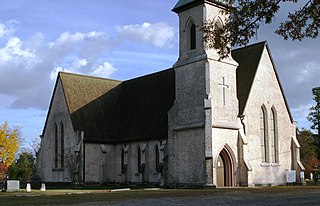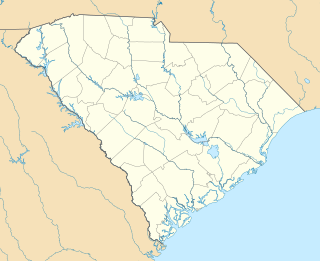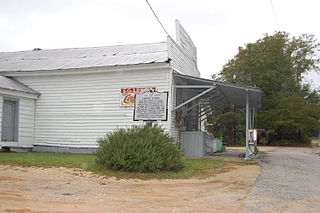
The Old State House Museum, formerly called the Arkansas State House, is the oldest surviving capitol building west of the Mississippi River. It was the site of the 1861 secession debate, as well as the 1868 Constitutional Convention when delegates agreed to ensure voting rights for freedmen and establish public schools.

The Old Campus District, University of South Carolina, is a historic district centered on The Horseshoe on the main campus of the University of South Carolina in Columbia, South Carolina. On June 5, 1970, it was listed in the National Register of Historic Places. On April 19, 1996 MTV Unplugged filmed Hootie & the Blowfish's concert on The Horseshoe before the release of their second album Fairweather Johnson.

Borough House Plantation, also known as Borough House, Hillcrest Plantation and Anderson Place, is an historic plantation on South Carolina Highway 261, 0.8 miles (1.3 km) north of its intersection with U.S. Route 76/US Route 378 in Stateburg, in the High Hills of Santee near Sumter, South Carolina. A National Historic Landmark, the plantation is noted as the largest assemblage of high-style pisé structures in the United States. The main house and six buildings on the plantation were built using this technique, beginning in 1821. The plantation is also notable as the home of Confederate Army General Richard H. Anderson.

The James Petigru Boyce Chapel is a historic church building at 1306 Hampton Street in Columbia, South Carolina. It is a Greek Revival building built in 1859. A convention met here on December 17, 1860, whose delegates voted unanimously for South Carolina to secede from the United States, leading to the American Civil War. It was designated a National Historic Landmark as First Baptist Church, the role it played at the time.

Temple Sinai is an historic Reform synagogue located at 11 Church Street on the corner of West Hampton Avenue, in Sumter, South Carolina, United States. Built in 1912 of brick in the Moorish Revival style, Temple Sinai was added to the National Register of Historic Places on January 21, 1999. It is also known as Congregation Sinai, whose official name is the Sumter Society of Israelites.

The Stateburg Historic District is a historic district in Stateburg, in the High Hills of Santee area near Sumter, South Carolina in the United States. It includes two National Historic Landmarks, Borough House Plantation and the Church of the Holy Cross, and at least eight contributing properties within its boundaries. On February 24, 1971, it was added to the National Register of Historic Places. The historic district extends north and east of the town of Stateburg as far north as Meeting House Road and as far east as South Carolina Highway 441, covering an area of 5,066 acres (20.50 km2).

Singleton's Graveyard is an historic plantation cemetery located off SC 261 in the High Hills of Santee, 6 miles south of Wedgefield, South Carolina. On May 13, 1976, it was added to the National Register of Historic Places.

The Lenoir Store built in 1869 is an historic general store building located at 3240 Horatio Road in the High Hills of Santee community of Horatio, South Carolina. It stands on the same site where the Lenoir family has operated a general store since before 1808 and "is the oldest business establishment in Sumter County". Since 1900 it has served as the post office for Horatio Zip Code 29062. On July 3, 1997, it was added to the National Register of Historic Places. As of that date, it was still being operated by members of the Lenoir family. Lenoir is pronounced le-nore or len-wa by some of its more northern members.

The Sumter County Courthouse, built in 1907, is an historic courthouse located at 141 North Main Street in the city of Sumter in Sumter County, South Carolina. It was designed in the Beaux Arts style by Darlington native William Augustus Edwards who designed eight other South Carolina courthouses as well as academic buildings at 12 institutions in Florida, Georgia and South Carolina. It was built in an I-shape. In the early 1960s it was enlarged and remodeled. On June 16, 2004, it was added to the National Register of Historic Places. It is located in the Sumter Historic District.
William Augustus Edwards, also known as William A. Edwards was an Atlanta-based American architect renowned for the educational buildings, courthouses and other public and private buildings that he designed in Florida, Georgia and his native South Carolina. More than 25 of his works have been listed on the National Register of Historic Places.

Liberty Colored High School is a former high school for African-American students in Liberty, South Carolina during the period of racial segregation. It originally was called Liberty Colored Junior High School. The building is now a community center known as the Rosewood Center. It is at East Main Street and Rosewood Street in Liberty. The school was built in 1937 on the site of a Rosenwald school that had burned down. Because of its role in the education of local African-American students, it was named to the National Register of Historic Places on April 18, 2003.

Unity Baptist Church is a historic African American Baptist church at Sumter and Hart Streets in Kershaw, Lancaster County, South Carolina. It was built in 1910, and is a Late Gothic Revival style frame church building. Also on the property are the contributing church's parsonage and its privy.

Ladson Presbyterian Church is a historic African American Presbyterian church located at 1720 Sumter Street in Columbia, South Carolina. The religious building was initially a chapel founded in 1838 and, rebuilt in 1896, and is a one-story-over-raised-basement, rectangular red brick building in the Renaissance Revival style. It has a front gable roof and features two brick entrance towers. The congregation was founded in 1838, as an offshoot congregation of the First Presbyterian Church.

Salem Black River Presbyterian Church is a historic church in Sumter, South Carolina.

Marysville School is a historic school building located near Pacolet, Spartanburg County, South Carolina. It built in 1915 by the Pacolet Manufacturing Company to serve the African-American community of Marystown. It is a 1 1/2-story, three room school building in an "L" shape. The school closed in 1954.

Goodwill Parochial School, also known as Goodwill Day School, is a historic parochial school for African American children located near Mayesville, Sumter County, South Carolina. It was built about 1890, and is a vernacular two-story, frame building. It is sheathed in weatherboard and set upon a brick pier foundation. The school was sponsored and supported by the Presbyterian Church in the U.S.A. until 1933. From 1933 to 1960, it was supported by Goodwill Presbyterian Church, when it was consolidated with the public schools.

Sumter Town Hall-Opera House, also known as the Sumter Academy of Music, is a historic town hall building located at Sumter, Sumter County, South Carolina. It was built in 1893, and is a four-story, ashlar brick Richardsonian Romanesque style building. It features a four-faced clock tower that serves as a focal point for the entire area. The building was remodeled internally in 1936, converting the first floor into a movie theater and the second floor opera house into offices.

Lincoln Park School, also known as Addor Community Center, is a historic Rosenwald School located near Pinebluff, Moore County, North Carolina. It was built in 1922, and is a one-story, four bay by three bay, side-gabled, weatherboarded, rectangular building in the Bungalow / American Craftsman style. It was built as a four teacher school. It was decommissioned as a school in 1949, and the building serves as the Addor Community Center.























